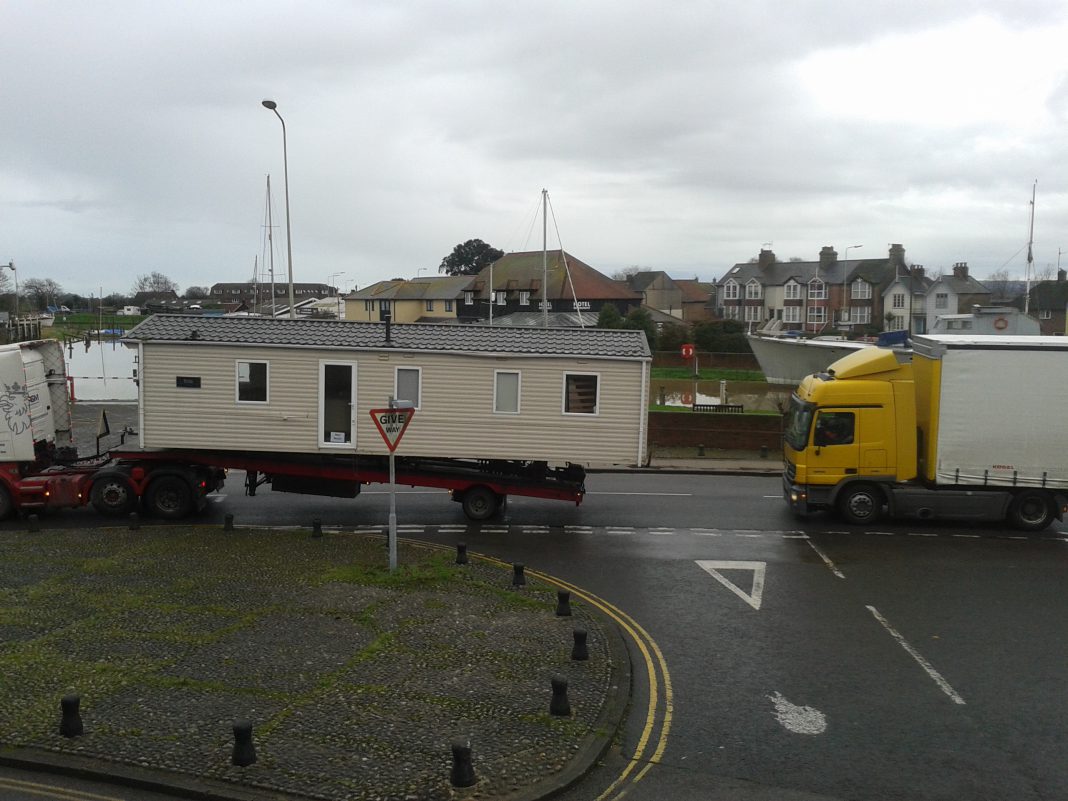Campaigners for a 20 miles per hour speed limit on Rye’s A roads, and particularly the New Road and the South Undercliff, have had their hopes dashed (for now) by the government department Highways England, saying that a 30mph limit was needed as a 20mph one would affect “the flow of traffic” – notwithstanding the growing spread of 20mph limits, particularly in London and on some very major roads there.
The “flow” of traffic is frequently affected already though, sometimes by the sheer volume at certain times, and sometimes by large loads like the mobile homes (pictured above) moving into, between or from the many leisure camps in the area. And that same flow is both vulnerable to flooding and to heavy lorries which start and finish their journeys in commercial sites in and around Rye – and there may be other threats too.
However Rye’s Neighbourhood Plan, which the town may be asked to vote for in a referendum later this year, recognises that the town has little clout where it has “neither the authority nor funding responsibility” and can only aspire to some changes.
Our second article in our series on Rye’s draft Neighbourhood Plan sets out some of those hopes.
Rye might, with the agreement of East Sussex County Council as the highways authority, get 20 mph on side roads, but any road that is either an A road or a B road is usually the responsibility of the Department for Transport – and any changes, even if agreed, may still be hit by budget restrictions, particularly if the project is very large.
Torquay, for example, has just got a bypass because the main road into the town was very narrow and frequently jammed in summer months. The need was recognised long ago, but it took nearly 25 years for the project to get funding and for it to rise slowly up the list until it had priority.
Probably for these reasons, the Campaign For Action in Rye focused more on 20 mph limits on side roads not controlled by the Department for Transport, and the Neighbourhood Plan takes a similar line currently – though there are voices wanting a different approach.
Current campaigners for either 20mph limits, or a bypass, or both , may have a long fight on their hands unless, perhaps, an “act of God” strikes the South Undercliff – and it might. The ancient Citadel is built on sandstone, landslips and rockfalls have happened and the sheer volume of traffic – and the ever increasing size and weight of the vehicles on our roads – might undermine the cliff face and effectively close the road.
A bypass therefore has also been an aspiration, as well as 20mph limits, but various proposals over the years have either been rejected or had low priority for funding – and the obstacles have been considerable, and may have got worse.
Much of the land to the north of Rye, the Weald, is an Area of Outstanding Natural Beauty while to the south towards and along the coast there are Sites of Special Scientific Interest, all of which could be obstacles to a bypass proposal. Last year however Natural England went a step further and announced that the government had agreed that the coastal area should become a Special Protection Area (SPA) as it was a Wetland of International Importance under an international convention.
The convention criteria included the fact that the area regularly supports up to 35,000 waterbirds in addition to supporting vulnerable, endangered or critically endangered species, and the SPA is now “one of a number of sites legally protected because they form part of a network of the most important nature conservation sites in Europe known as the Natura 2000 network,” Natural England told local residents in the SPA in March last year.
Going around Rye is therefore fraught with difficulties, but it is not clear whether to date anyone has proposed going over Rye –and in a number of places, usually town and city centres, road and rail has come to share routes or be in very close proximity. If high speed trains ares to come to Rye and on to Hastings and Bexhill, some work will inevitably be required on the existing line – and possibly a new bypass could go on stilts on top of it through Rye.
But it may be a long fight with the Department for Transport and Highways England.
Photo: Rye News library




The quickest and cheapest way of improving traffic flow around the town is to put double yellow lines along the A259 from Alsfords, along South Undercliff to the Kettle of Fish roundabout and enforce restrictions; it is constantly blocked by trade vans in the week and residents parking at weekends, including on the blind corner – not their fault as they are allowed to park there after 1pm on Saturday and all day Sunday – this is crazy, specially in the summer.
With reference to Mr Law’s comment the restrictions on South Undercliffe is enforceable daily from 08.00 to 18.00 and yes I agree that trade vans cause a problem but the parking on the A259 along the Strand is far worse as the official parking bays are taken up by long term parkers ie Locals. It is exacerbated by people parking either end on the double yellow lines not only does it narrow the road but if one is coming out on to the A259 from the Deals the left hand view is obscured, it is a wonder there has not been any accidents on this part of the road. To completely ban parking on this part of the A259 would increase the traffic flow. The argument that this would hurt trade in the shops in this area does not hold water as the vehicles rarely change from day to day.